The Center for Intelligent Power and Energy Systems (CiPES) of SIST is a subdivided research group focusing mainly on the study of electric power and energy. It studies topics including power generation, transmission/distribution, storage and utilization, and aims to propose reliable, efficient, low-carbon and intelligent power solutions for the sustainable development of domestic energy. Recently, CiPES published three papers addressing topics in Internet of Things (IoT) energy harvesting, power systems and power electronics, in top journals.
The first research study:
The Mechatronics and Energy Transformation Laboratory (METAL) led by Professor Liang Junrui, designed a vibrational-powered IoT development platform prototype called ViPSN and published a research article entitled “ViPSN: A Vibrational Powered IoT Platform” in IEEE Internet of Things Journal, a leading academic journal in the field of Internet of Things (IoT).
For the ViPSN design, the team comprehensibly analyzed the mechanical, electrical, and information parts necessary for making up a complete vibration-powered IoT system, as well as emphasizing the synergistic effect of the three parts. ViPSN is so far one of the most complete research and development platforms for vibration-powered IoT which differs from other platforms by the following characteristics: 1) It contains six essential parts of battery-free IoT, including power generation, power conversion, power enhancement, power management, energy usage, and edge demonstration unit; 2) An enhanced energy management unit with the storage energy awareness was built by adding a complementary design to the commercial power management integrated circuit (IC); 3) It has been proven through experiments that this system design is compatible with complex vibration situations like impacts or random vibrations. It is also compatible with different kinetic energy harvesters such as piezoelectric, electromagnetic, or triboelectric generators; 4) The software and hardware of the ViPSN platform are all open-sourced on Github; and 5) ViPSN used a modular design, which can facilitate the reconstruction, replacement, upgrading, and expansion for each functional module.
The above work was independently conducted by the faculty members and students from the CiPES. Second year Ph.D. candidate Li Xin was the first author. The corresponding author was Prof. Liang Junrui. This work was supported by the National Natural Science Foundation of China, ShanghaiTech University, and Shanghai Key Laboratory of Energy Engineering Mechanics. In addition, the METAL group has filed two patents for ViPSN and its related designs.
Paper link: https://ieeexplore.ieee.org/document/9169698
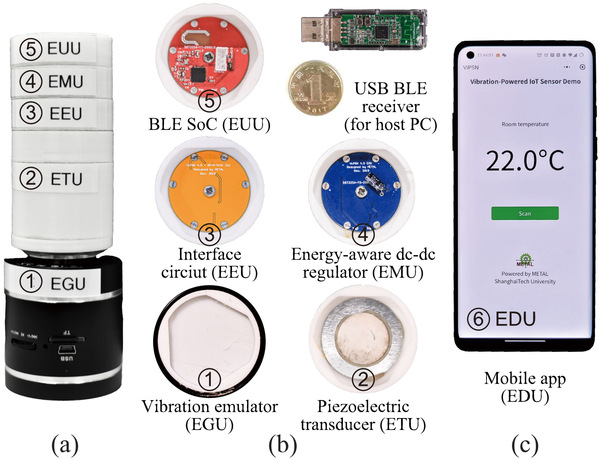
Fig. 1. ViPSN prototype including six modules. (a) System assembly. (b) Module breakdown. (c) Edge demonstration unit.
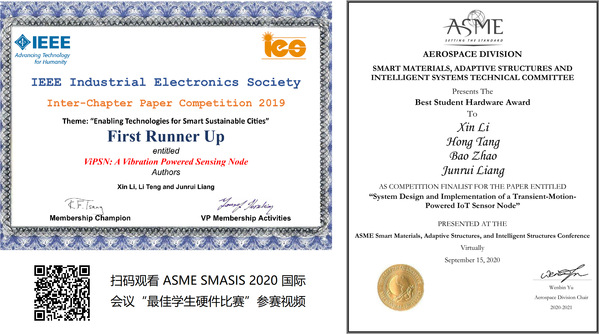
Fig. 2. The ViPSN Project has won two paper awards from IEEE (Institute of Electrical and Electronic Engineers) and ASME (American Society of Mechanical Engineers).
The second research study:
High voltage direct current (HVDC) power transmission systems are widely deployed in modern power grids to efficiently transmit large amounts of power over long distances. The modular multilevel converters (MMC) -based flexible HVDC (MMC-HVDC) power system is considered to be one of the promising solutions for flexible integration of large amounts of renewable energy. However, faults sometimes occur in the MMC-HVDC transmission lines. The location of a fault within transmission lines needs to be accurately determined, in order to minimize the effort of fault searching and to reduce the power outage time as well as the operating costs.
Recently, Prof. Liu Yu’s Group proposed a novel fault location method in transmission lines of MMC-HVDC grids based on dynamic state estimation (DSE) and gradient descent. This work was published in an article entitled “Transmission Line Fault Location in MMC-HVDC Grids Based on Dynamic State Estimation and Gradient Descent”, in IEEE Transactions on Power Delivery, the leading peer-reviewed journal in the field of power system protection.
In this method, the dynamic model of the flexible DC transmission line was established first to accurately describe the physical laws the DC line obeyed during the fault. The DSE procedure was then applied to solve the dynamic states of the system and to check the consistency between the measurements and the dynamic model. In the last step, the fault location was solved through gradient descent: the correct fault location corresponds to the best consistency. Extensive numerical experiments showed that the proposed method worked with a relatively low sampling rate of 20 kilo-samples per second and a short data window of 5 ms, and can accurately locate faults regardless of the fault types, resistances and locations (shown in Fig.3).
First year Ph.D. candidate Wang Binglin was the first author, and Prof. Liu Yu was the corresponding author. The work was supported by the National Natural Science Foundation of China.
Paper link: https://ieeexplore.ieee.org/document/9154583
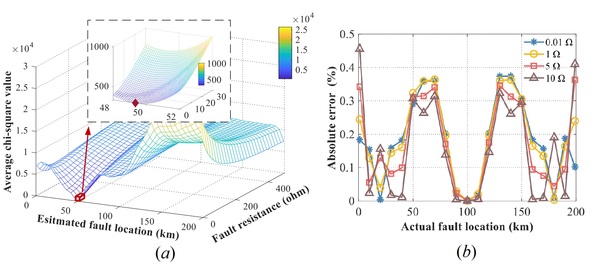
Fig. 3. Results of the fault location by using the proposed method (a) Consistency with different fault locations and resistances, 0.01 ohm positive pole to ground fault at 50 km (the minimum of the surfacecorresponds to the actual fault location) (b) Fault location results, a group of positive pole to ground faults (low fault resistances and different fault locations)
The third research study:
When it comes to the on-board charger of electric vehicles (EV), the terminal voltage of batteries can vary across an extremely wide range due to different battery states, making it a research priority, in EV charging technology, to find ways of adapting to a wide output voltage range so as to provide a safe and efficient charging solution for EV batteries.
Prof. Wang Haoyu’s group proposed a new LLC resonant converter topology with an ultra-wide output range based on adjustable transformer ratio and reconfigurable bridge. The converter used an adjustable turns ratio transformer and reconfigurable bridge structure, which can effectively extend the converter voltage gain and reduce the loss. This result was published in the renowned journal IEEE Transactions on Industrial Electronics, in an article entitled “An Ultra-Wide Output Range LLC Resonant Converter Based on Adjustable Turns Ratio Transformer and Reconfigurable Bridge”.
The topology utilizes an adjustable turns ratio transformer which can be controlled by switches and reconfigurable bridge on the primary side. By methodically designing the turns of the transformer, the gain of the converter can be effectively extended (60-450V). Unlike the traditional scheme, the converter can work in different transformer turns ratios, and the primary side operates in half bridge when the output voltage is extremely low, which greatly reduces the requirements of the voltage gain on magnetizing inductance and switching frequency range. It can significantly reduce the conduction and switching losses, improving the efficiency of the converter.
First year Ph.D. candidate Shu Dongdong of Prof. Wang’s group was the first author, and Prof. Wang was the corresponding author.
Paper link: https://ieeexplore.ieee.org/document/9145821/
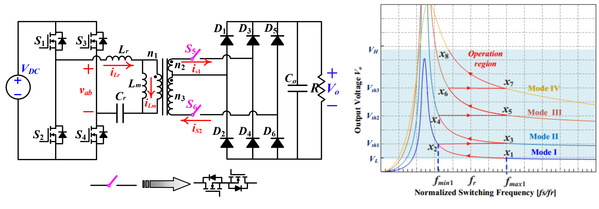
Fig. 4. Schematic of the proposed reconfigurable LLC topology and its voltage gain profile
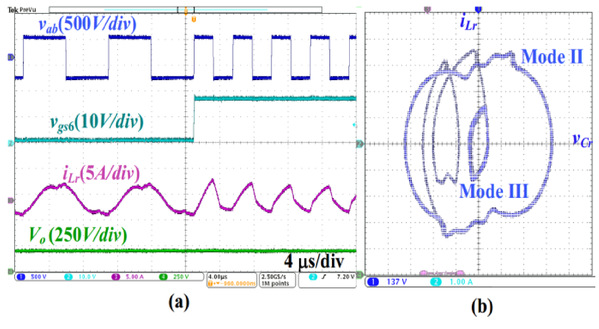
Fig. 5. Experimental transition between from Mode II to Mode III